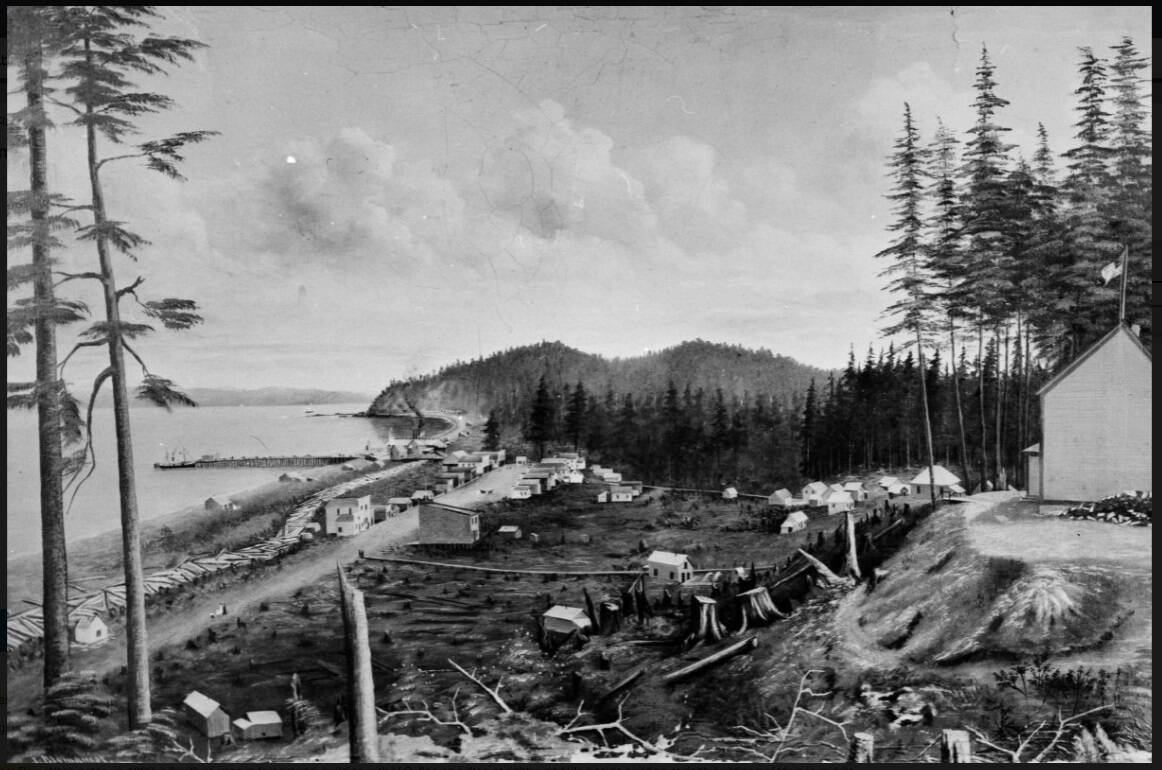By Karolyn Burdick
This sketch/drawing of “East Clallam” (from a painting by an unknown artist), is the earliest record of the development of the town now known as Clallam Bay.
H.C. Fairservice, who wrote the article, “Clallam Bay (East Clallam),” for “Jimmy Come Lately, history of Clallam County,” offered the picture for publication as part of his story, but it was not used in the book. That is unfortunate because it is truly a snapshot in time.
The large building on the right is a newly constructed school, which opened in 1892. It was located west of what is now Highway 112, and farther south than the current school grounds.
To the left of the school, a cluster of homes is shown, including one with a “round” roof, which was known as “Lookout Cottage.” It was the residence of George and Libbie O’Brien. O’Brien came to East Clallam in 1890 and established a newspaper, the Clallam Bay Record, to publish legal filings of homestead and timber claims. He married a local girl, and became a very active promotor of the new town.
One of the large buildings in the center of the painting (not sure which) was built by George and Jack Sands, and for some time served as a hospital. Later, it became the Hans Chesnes’ residence.
On the salt water, a boat is landing at the dock, which had just been built by Alston Fairservice. From that time until the 1930s, steamers landed there three days a week. The dock enabled East Clallam to become a reliable connection point for passengers, mail and freight, serving homesteaders, timber claimers, and entrepreneurs all over the western Peninsula.
Many logs can be seen in the Clallam River, probably from the earliest logging in the area (1891), which was done by Herb Dempsey and Tom Paine with five yoke of oxen. Logs were driven down the river during high water, or when water was released from a dam built on Last Creek. The river was filled with logs both above and below the town.
Those logs were milled at the sawmill operated by Mike Earles and Frank Donahue; it was on the spit just east of the dock. The sawmill had a short life – sources disagree about how short! H.C. Fairservice said the mill burned in 1891 (but the drawing shows it as operating in 1892); another (unknown) source said it burned in 1892; William Peterson said it was “closed” in about 1895. Maybe it was rebuilt after it burned….?
There are a number of buildings along the river west of the bridge, including a hotel which was probably one of the first buildings in the town. Frank Donahue owned it as well as the sawmill, then later sold it to Fred Rudisile. That hotel burned in the 1907 Clallam Bay fire.
On the south side of the east-west “road,” near the bridge to the dock, is Alston Fairservice’s general merchandise store. Farther west, in the center of the picture, is the Odd Fellows Hall, which was later moved 1000 feet east, and joined to the Fairservice store.
In the foreground of the picture, a lone building is connected to the “road” by a plank walkway. The rough “stump-ranch” appearance of that area, and the need for the walk, indicates that the entire area was swampy.
In the lower-left corner, almost hidden between two trees, is a small house with a hip roof. It is the oldest building still existing in Clallam Bay. Since 1910, it has been extensively remodeled and expanded. For many years, it served as a “bed-and-breakfast.” Now, only the roofline marks its history.
In his description of the drawing/painting, H.C. Fairservice says, “Shows town of about 1500 people.” His estimate does not match census data or personal narratives from that time period; most accounts indicate a population of 150-300 residents.



